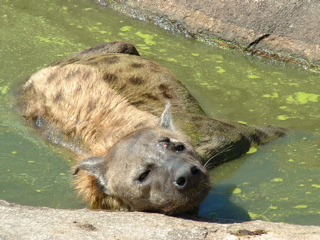Spotted hyaena
| Hyaenas | ||||||||||||
|---|---|---|---|---|---|---|---|---|---|---|---|---|
| Scientific classification | ||||||||||||
| ||||||||||||
| [[taxon|Subfamilies and Genera]] | ||||||||||||

The spotted Hyaena Crocuta crocuta, is the most recognizable of the hyaena species. Vilified in modern theatre and media, the spotted hyaena is one of the most misunderstood animals today.
Description
The spotted hyaena Hyaenidae is 1.2-1.8 m in length, it has a tail being of 25 cm, and stands approximately 85 cm at the shoulder. Spotted hyaenas weigh between 60 and 80 kg. Sexual dimorphism favours the females of the species, which are larger and stouter than the males. Spotted hyaenas share the typical ‘hyaena’ stature, that being high at the shoulders and lower in the hindquarters. The spotted hyaena has short, dense coat of light off white to fawn, with brown to black spots irregularly patterned on the body. The ears of the spotted hyaenas are rounded and broad and the muzzle is typically dark brown.[1] [2]
Behaviour
Spotted hyaenas live in matriarchal societies, which are rigidly structured. The clan size can range from 4 to an average of 47 (in the Serengeti) individuals. While members of the clan roam over a large area, at times up to 2000 km2, but only defend the central portion of that range. One to two cubs are born at many time of the year; cubs born from different females are kept in the same den, thus giving the impression of larger litters. The female spotted hyaena has external genitalia, this combined with females being larger than males gave rise to the idea that this species was hermaphroditic. The spotted hyaena is the most vocal member of the hyaenid family, able to produce a range of whoops, calls and cackles <ref name="Skinner">
Diet
Once thought to be purely scavengers, it is now known that spotted hyaenas are consummate hunters, at times foraging alone and at other times working together in order to bring down large prey species. Even lone individuals have been known to bring down wildebeest, an animal two times its own mass. <ref name= “Skinner”>. That being said spotted hyaenas will scavenge carrion and even drive other predators off of their prey. They are known to collect vast quantities of faunal remains in their dens, said collections of bone are a direct reflection of the other species found in the region at the time of collection <ref name="Kuhn"> Template:Cite Thesis
Geographical distribution
The range of spotted hyaenas is from south of the Sahara desert all the way through to norhten parts of South Africa. Spotted hyaenas are notably absent from the Congo basin and the southern regions of West Africa <ref name= “Skinner”>
Status
Listed as lower risk; conservation dependant by IUCN
